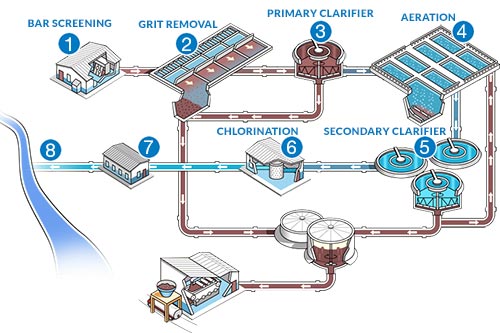Revolutionizing Wastewater Treatment with Eco-Friendly Innovations
Recognizing Wastewater Treatment Processes and Their Ecological Influence
The intricacies of wastewater therapy processes play an essential duty in mitigating ecological challenges associated with water pollution. Each stage, from preliminary to innovative therapies, is designed to resolve details impurities, eventually securing both public health and marine communities.
Summary of Wastewater Treatment
Exactly how is wastewater transformed into a safe source for the environment? Wastewater therapy is an important process developed to get rid of impurities from made use of water, consequently safeguarding public wellness and securing ecosystems. This process starts with the collection of wastewater from household, commercial, and commercial resources, which is after that directed to therapy centers.
At these facilities, various physical, chemical, and organic methods are utilized to treat the wastewater. First testing removes huge debris, followed by sedimentation to different heavier solids. Consequently, organic therapies, such as activated sludge processes, use bacteria to damage down organic issue. These techniques not only lower pollutant levels but additionally assist in the recovery of important nutrients.
The dealt with effluent can be securely released right into all-natural water bodies or recycled for irrigation and industrial objectives, advertising resource preservation. Additionally, the therapy process generates biosolids, which can be repurposed as plant foods or dirt changes, better boosting sustainability.
Stages of Treatment Procedures
The wastewater therapy procedure commonly contains three primary phases: initial, main, and additional treatment. Each phase serves a distinct role in minimizing the contaminant tons and guaranteeing the effluent meets ecological requirements before discharge.

The key treatment phase concentrates on the physical splitting up of suspended solids from the wastewater. Via sedimentation, larger fragments resolve at the bottom of sedimentation containers, creating sludge, while lighter materials, such as oils and oils, float to the surface area and are skimmed. This process significantly decreases the natural and not natural load in the wastewater.
Secondary therapy is a biological procedure intended at additional reducing the concentration of natural matter. This stage is necessary for accomplishing the needed biochemical oxygen need (BOD) reduction, inevitably leading to cleaner effluent ready for discharge or additional treatment.

Advanced Treatment Technologies
Complying with the secondary treatment processes, progressed therapy innovations play an essential role in additional enhancing the quality of treated wastewater. These modern technologies are designed to get rid of recurring pollutants that are not effectively eliminated throughout key and second treatments, ensuring the effluent meets strict regulative requirements.
Amongst the extensively used advanced treatment techniques are membrane layer filtering, reverse osmosis, and advanced oxidation procedures. Membrane filtration, consisting of microfiltration and ultrafiltration, works in separating fine fragments, virus, and colloids from the water (Wastewater). Reverse osmosis utilizes semi-permeable membrane layers to get rid of dissolved solids, resulting in top notch water ideal for numerous applications
Advanced oxidation procedures (AOPs) use solid oxidants to weaken natural contaminants, consisting of drugs and personal treatment products that are resistant to conventional therapy. These methods improve the biodegradability of complex compounds, facilitating their elimination.
An additional significant innovation is using organic nutrient elimination procedures, which especially target nitrogen and phosphorus, protecting against eutrophication in getting water bodies. Generally, sophisticated therapy innovations are important for achieving greater levels of filtration, advertising water reuse, and safeguarding public wellness while resolving the obstacles associated with wastewater monitoring.
Environmental Benefits of Therapy
Countless environmental advantages emerge from reliable wastewater therapy processes that add to ecosystem wellness and sustainability. Mostly, these processes dramatically minimize the launch of unsafe pollutants into natural water bodies, which helps preserve aquatic ecosystems. By getting rid of impurities such as hefty metals, nutrients, and pathogens, treated wastewater mitigates the risk of waterborne illness and advertises biodiversity in aquatic settings.
Additionally, wastewater treatment facilities typically utilize innovative innovations that enable water recycling and reuse. This practice not only conserves fresh about his water sources however likewise minimizes the need on all-natural water materials. Boosted nutrient removal from wastewater can likewise stop eutrophication, a procedure that results in algal blossoms and subsequent oxygen depletion in water systems.
Furthermore, effective therapy processes can lessen greenhouse discover this info here gas emissions, particularly methane and nitrous oxide, which are typically released during neglected wastewater decomposition. By recording and using biogas from anaerobic digesters, centers can convert waste into renewable power, thereby adding to a decrease in fossil gas reliance.
Challenges and Future Trends
While the environmental benefits of wastewater treatment are clear, a number of obstacles continue that impede optimum end results in this field. One significant concern is aging infrastructure, which often brings about inadequacies and increased functional prices - Wastewater. Numerous treatment plants were developed years earlier, and their abilities do not line up with modern-day demands, which consist of stricter regulatory requirements and greater volumes of wastewater due to urbanization
Looking in advance, there is an expanding emphasis on resource healing and circular economy principles within wastewater therapy. Advancements such as anaerobic food digestion, which can create biogas, and progressed purification modern technologies are getting traction. These approaches not just improve treatment efficiency however also promote sustainability.
Eventually, attending to these challenges needs cooperation among stakeholders, financial investment in innovation, and a dedication to recurring research. By embracing these trends, the wastewater treatment market can develop to meet the needs of an altering atmosphere and culture.
Conclusion
In conclusion, wastewater therapy procedures play a crucial duty in boosting environmental top quality and public health. The multi-stage treatment structure, paired with advanced modern technologies, successfully mitigates pollution and advertises lasting water administration. By addressing residual contaminants and minimizing nutrition drainage, these procedures add to the conservation of aquatic communities and the decrease of discover this info here greenhouse gas exhausts. Proceeded advancements and adaptations in therapy techniques will certainly be essential for conquering arising difficulties and ensuring the sustainability of natural deposits (Wastewater).